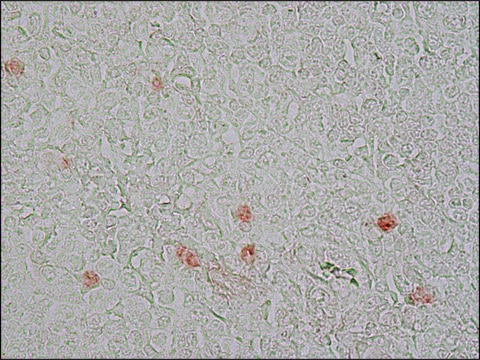P8999
Anti-p53 antibody, Mouse monoclonal
clone DO-7, purified from hybridoma cell culture
Synonim(y):
Anti-p53 antibody, Mouse monoclonal, Anti-TRP53, Anti-Transformation-related protein 53
About This Item
Polecane produkty
pochodzenie biologiczne
mouse
Poziom jakości
białko sprzężone
unconjugated
forma przeciwciała
purified immunoglobulin
rodzaj przeciwciała
primary antibodies
klon
DO-7, monoclonal
Postać
buffered aqueous solution
masa cząsteczkowa
antigen ~53 kDa
reaktywność gatunkowa
human
stężenie
~2 mg/mL
metody
immunocytochemistry: suitable
immunohistochemistry: suitable
immunoprecipitation (IP): suitable
indirect ELISA: suitable
western blot: 0.1-0.2 μg/mL using human A431
izotyp
IgG2b
numer dostępu UniProt
Warunki transportu
dry ice
temp. przechowywania
−20°C
docelowa modyfikacja potranslacyjna
unmodified
informacje o genach
human ... TP53(7157)
Szukasz podobnych produktów? Odwiedź Przewodnik dotyczący porównywania produktów
Opis ogólny
Zastosowanie
- immunoblotting
- enzyme linked immunosorbent assay (ELISA)
- immunocytochemistry
- immunohistochemistry
- immunoprecipitation
Działania biochem./fizjol.
Postać fizyczna
Oświadczenie o zrzeczeniu się odpowiedzialności
Not finding the right product?
Try our Narzędzie selektora produktów.
polecane
produkt powiązany
Kod klasy składowania
10 - Combustible liquids
Klasa zagrożenia wodnego (WGK)
WGK 3
Temperatura zapłonu (°F)
Not applicable
Temperatura zapłonu (°C)
Not applicable
Środki ochrony indywidualnej
Eyeshields, Gloves, multi-purpose combination respirator cartridge (US)
Certyfikaty analizy (CoA)
Poszukaj Certyfikaty analizy (CoA), wpisując numer partii/serii produktów. Numery serii i partii można znaleźć na etykiecie produktu po słowach „seria” lub „partia”.
Masz już ten produkt?
Dokumenty związane z niedawno zakupionymi produktami zostały zamieszczone w Bibliotece dokumentów.
Produkty
p53 regulates gene expression, cell cycle control and functions as a tumor suppressor. Inactivation of p53 is closely tied to cancer development.
p53 reguluje ekspresję genów, kontrolę cyklu komórkowego i działa jako supresor nowotworów. Inaktywacja p53 jest ściśle związana z rozwojem raka.
Cancer stem cell media, spheroid plates and cancer stem cell markers to culture and characterize CSC populations.
Nasz zespół naukowców ma doświadczenie we wszystkich obszarach badań, w tym w naukach przyrodniczych, materiałoznawstwie, syntezie chemicznej, chromatografii, analityce i wielu innych dziedzinach.
Skontaktuj się z zespołem ds. pomocy technicznej








